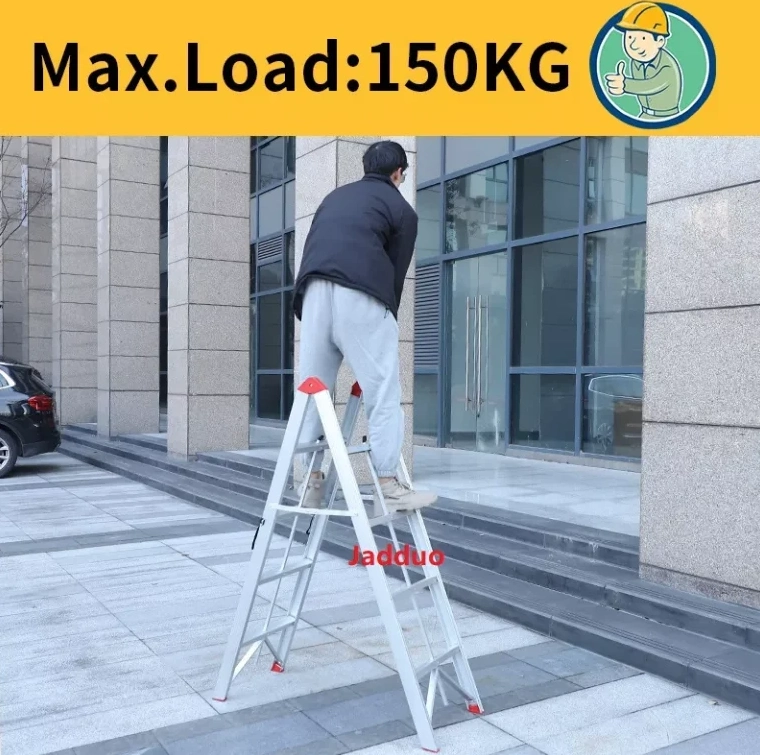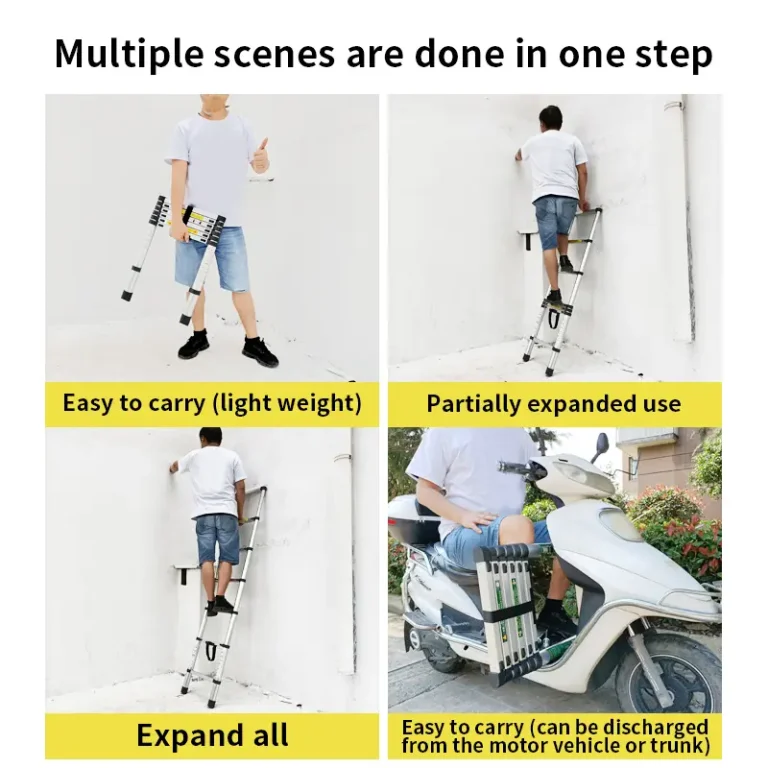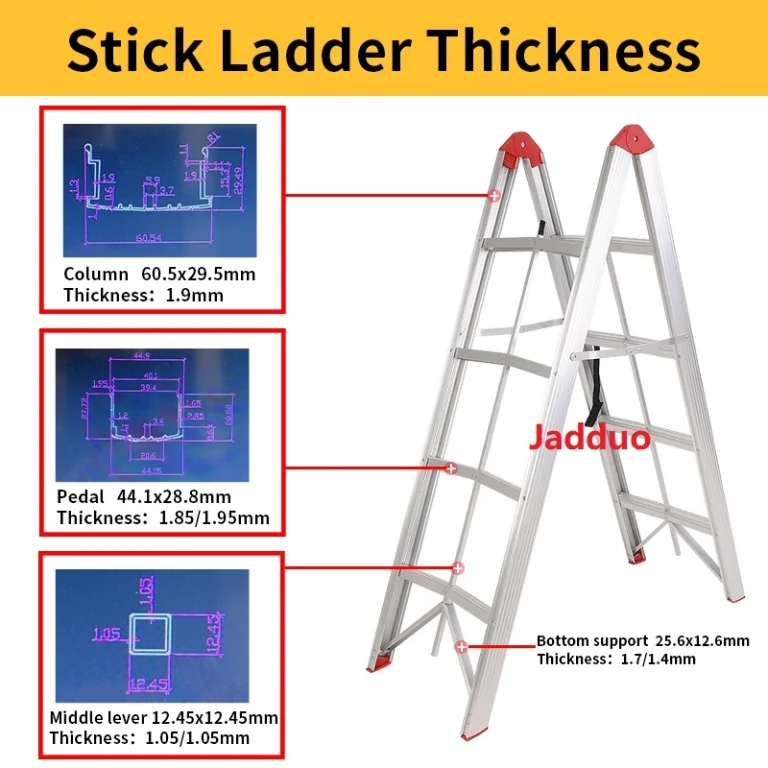Setting up a telescopic ladder the right way keeps it safe and sturdy. This guide covers the main parts, checks for strength, safety rules. It’ll help you put the ladder in place securely, whether indoors or out.

Core Components of a Telescopic Ladder System
Before you start installing a telescopic ladder, you gotta know its parts. It’s usually made of aluminum alloy tubes that slide into each other. It has locking clips at each section, non-slip feet, and sometimes extra stabilizers or wall hooks. The aluminum alloy is light, strong, and doesn’t rust easily. That makes it great for homes, job sites, or even outdoors.
The locking clips are super important. They stop the ladder from collapsing while you’re climbing. Non-slip feet and balance bars grip the ground tight and keep the ladder steady side-to-side. For A-frame setups, crossbars are a must. They stop the ladder from tipping over, even if it’s got locks.
For example, JADDUO’s ladders use tough aluminum alloy and strong locks. Their design makes sure you’re safe, whether you’re climbing to a roof or fixing something in a warehouse.
Structural Checks Are Required Before Installation
Putting up a telescopic ladder isn’t just about sticking it in place. You need to check the wall or platform it’ll be attached to. First, make sure the surface can hold the ladder’s weight, plus you and your tools—often over 120–150kg. The overlapping tube design helps spread out the weight evenly.
Also, think about rung spacing. Use 30cm spacing for tight spots like attics. Go with 40cm for open areas like construction sites. Pick the spacing based on your space, height, and job needs to stay safe and work fast.
For instance, if you’re setting up a ladder in a small garage, 30cm rungs make climbing easier. In a big warehouse, 40cm gives you more room to move.
Compliance with Safety Standards Is Ensured
Safety rules like EN131 (Europe), ANSI A14 (US), and GS (Germany) set standards for telescopic ladders. They test for weight (up to 150kg), non-slip grips, and stress handling. Certifications like CE, GS, ANSI, EN131, and RoHS (available on request) show a ladder meets these rules. Always pick a ladder with these certifications, especially for work sites, to avoid trouble.
JADDUO’s ladders, for example, pass these tests. They’re built to handle 150kg loads and tough conditions, making them a solid choice for pros.
Preparation of the Installation Site Is Essential
Load-Bearing Surfaces Must Be Evaluated
Mounting brackets need a surface that can hold the ladder, your weight, and any tools—think 120–150kg or more. Use a stud finder for wood walls or a test for concrete to check strength. A weak wall can make the ladder wobble or fall, which is super risky.
Best Mounting Location Is Selected
Pick a spot that gives straight-up access to your work area. Keep it clear of busy walkways unless you add barriers or signs. This keeps workers from tripping and lets you climb easily.
Say you’re working in a storehouse. Put the ladder near the shelves you need, but not where forklifts zoom by.
Environmental Conditions Affect Installation
Outdoor setups face cold (-20°C), heat (50°C), rain, sun, or chemicals. Aluminum alloy ladders, like JADDUO’s, fight rust and stay strong in all kinds of weather. That means they work great for long-term use outside.
For instance, a JADDUO ladder on a coastal job site won’t rust, even with salty air hitting it daily.
Correct Step-by-Step Installation Process Is Followed
Ladder Is Positioned Safely
Set the base on flat ground at a 75° angle for a straight ladder. For A-frame mode, spread both sides evenly and lock the joints. This keeps the ladder steady while you climb.
On a job site, for instance, you’d check the ground with a level before setting a JADDUO ladder at the right angle.
Proper Extension/Retraction Functionality Is Confirmed
After setting it up:
- Pull each section out until you hear a “click.”
- Push down on each rung to test strength.
- Bring it back in from top to bottom.
- Slide sections gently to check smooth movement.
JADDUO’s One-button Telescopic Tent Ladder, for example, clicks clearly when locked, so you know it’s secure.
Ladder Is Integrated Seamlessly Into Infrastructure
JADDUO’s One-button Telescopic Tent Ladder is built for easy use in rooftop tents or RVs. But it also works great for factories or warehouses. Its anodized aluminum and adjustable lengths (2–2.6 meters) make it fit lots of jobs. JADDUO, based in Yongkang—China’s “Hardware Capital”—ships over 300,000 units a year to 50+ countries. Their ladders are all about precision and toughness.
For extra comfort, check out JADDUO’s Black Oxidation 6cm Widened Step Telescopic Tent Ladder. Its wide, non-slip steps cut foot tiredness and grip better, especially on wet or muddy sites. Imagine climbing to a rooftop tent after a long day—those wide steps feel like a treat.

Checks Are Required After Installation Is Complete
Retraction Mechanisms Are Tested Efficiently
Pull each section in slowly. Check if locks release smoothly and tubes slide without sticking. Do this after every setup to catch problems early.
Load Tests Are Conducted Post Setup
Test with real weight. Stack sandbags (about 150kg) on the middle rungs when extended. This mimics a worker with tools and checks if the ladder holds up.
Maintenance Is Needed Over Time to Ensure Longevity
Routine Inspections Are Crucial
Check these every month:
- How quick the locks work.
- Wear on rubber feet.
Components Are Cleaned and Lubricated Properly
Wipe the ladder with a dry cloth after use. Keep water out of joints. Spray silicone—not oily stuff—on moving parts every three months. Oily sprays attract dust and make things sticky. If the ladder sits unused, add a bit of oil to joints.
Replace broken rungs or worn-out feet right away. If rubber feet are half-worn, swap them out to keep the ladder steady.
Accessories Improve Performance Further
Non-slip feet come standard, but wall mounts add extra safety for tall climbs. Balance bars spread weight evenly, great for uneven ground. JADDUO’s balance bars stop wobbling, making climbs feel solid.
Some JADDUO models offer hooks or platforms for specific jobs, like RV camping or scaffolding work. Their telescopic tent ladder with hook is perfect for rooftop tents.
FAQs
Q1. Do telescopic ladders have to be fully extended?
No, telescopic ladders do not have to be fully extended. They can be used at any height between their fully collapsed position and their maximum extended length.
Q2. How often should I lubricate my telescopic ladder?
Every three months under regular use—or monthly if used outdoors frequently in dusty environments.
Q3. Are telescoping ladders worth it?
A telescoping ladder may not be perfect for every situation, but they’re extremely handy for DIYers with limited storage space or who work at multiple locations.









